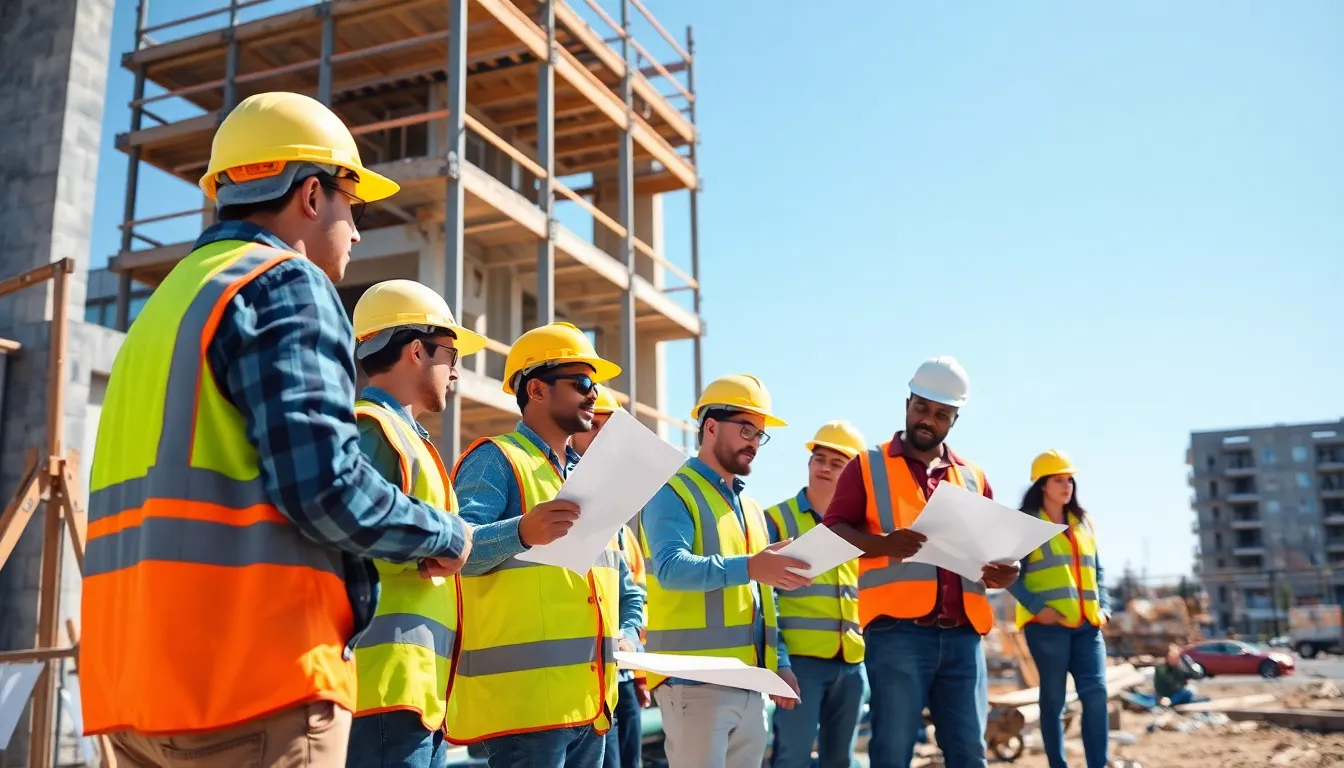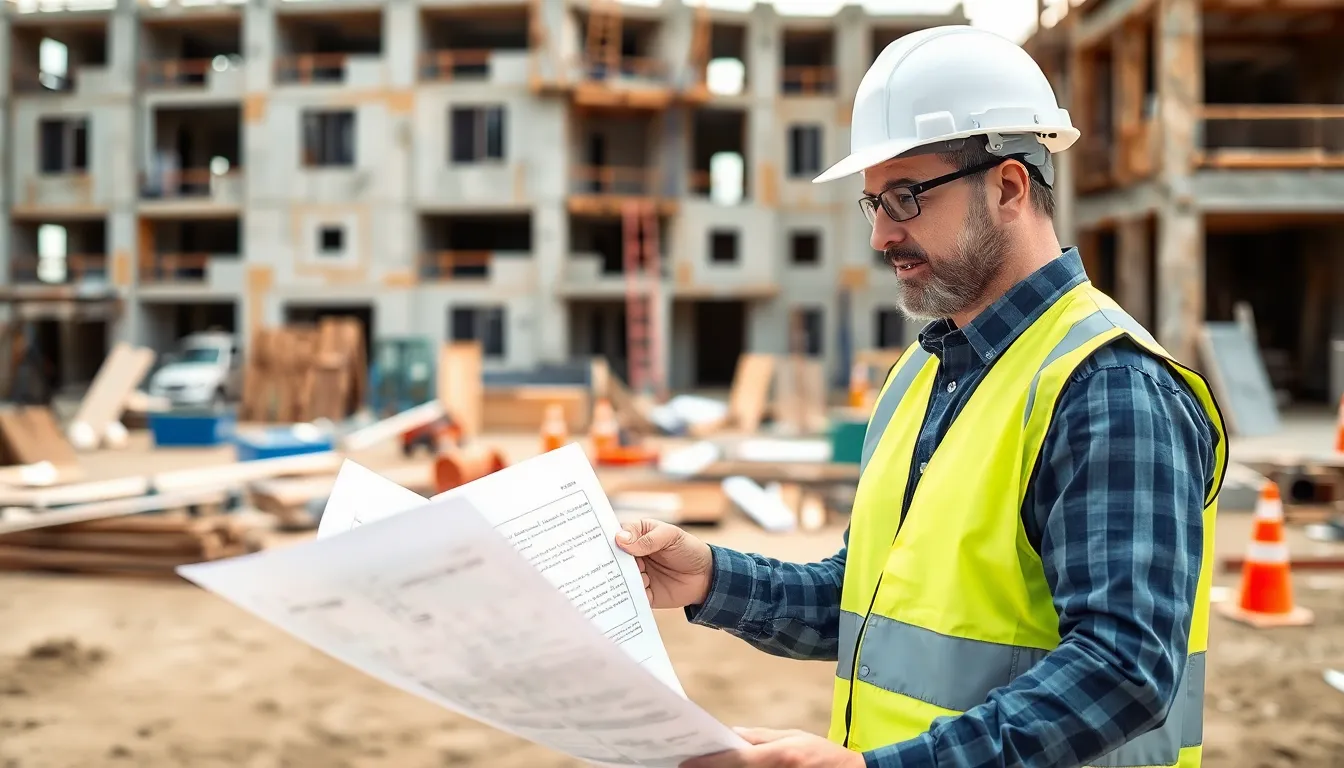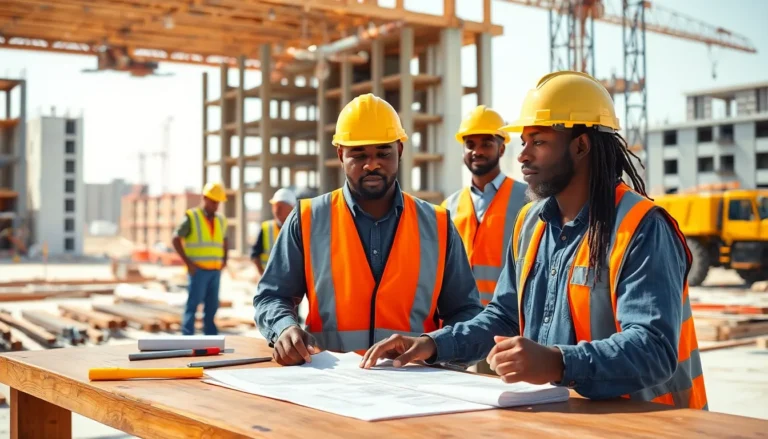Table of Contents
ToggleIn the bustling world of construction, where cranes tower like giants and blueprints are the dreams of tomorrow, understanding building construction law can feel like navigating a maze blindfolded. It’s the unsung hero of the industry, ensuring that projects don’t just rise but do so with legal finesse. Imagine trying to build a skyscraper without knowing the rules—it’s like trying to play chess without knowing the pieces!
From contracts that read like ancient scrolls to regulations that could make a lawyer weep, construction law is both a challenge and a necessity. Whether you’re a seasoned contractor or a newbie dreaming of your first project, grasping these legalities will save headaches, and money, and maybe even a few friendships. Dive into the world of building construction law and discover how to construct your projects on a solid legal foundation.
Overview of Building Construction Law
Building construction law governs the legal aspects of construction projects. These laws encompass a wide range of regulations, including zoning, permits, safety standards, and environmental considerations. Understanding these regulations is vital for all parties involved in the construction process. Failing to comply with these legal standards can lead to significant delays or financial penalties.
Multiple contracts play a key role in building construction law. Contracts outline the responsibilities of all parties, such as contractors, subcontractors, and suppliers. They establish the timing and scope of work, payment terms, and dispute resolution procedures. Clear and concise contracts help prevent misunderstandings and conflicts during the construction process.
Licensing and bonding requirements are also important components of building construction law. Each state has its own licensing regulations, which ensure that contractors meet specific qualifications and standards. Bonding requirements offer additional protection for project owners, ensuring financial compensation in cases of contractor defaults.
Dispute resolution mechanisms are essential in addressing conflicts that arise during construction projects. Mediation, arbitration, and litigation provide different avenues for resolving issues. Many construction contracts include clauses that mandate specific resolution methods, reducing legal uncertainty.
Compliance with building codes is critical for project safety and legality. These codes set minimum standards for construction practices, ensuring the safety and well-being of the public. Failure to adhere to these codes can lead to fines or the need for costly renovations.
Engaging legal professionals with expertise in building construction law can enhance project viability. They can assist with contract negotiation, regulatory compliance, and dispute resolution. Making informed legal decisions can significantly impact the success of construction projects.
Key Regulations in Building Construction Law

Understanding key regulations ensures compliance and the smooth progress of construction projects. Significant aspects include local building codes and national regulations.
Local Building Codes
Local building codes set specific standards for construction within a municipality or county. These codes cover various elements, including structural integrity, material usage, and safety protocols. Regulations vary widely across jurisdictions, making it essential for contractors to familiarize themselves with local requirements. Officials often require inspections at different project stages to verify adherence to these codes. Failing to comply can lead to legal repercussions and financial losses.
National Regulations
National regulations establish a framework for building construction across the country. The International Building Code (IBC) serves as a model code which many states adopt. This code addresses structural safety, fire prevention, and accessibility standards. Compliance with federal regulations, including the Occupational Safety and Health Administration (OSHA) guidelines, is also mandatory. These regulations ensure worker safety and protect the environment during construction activities. National standards are critical for uniformity and safety across state lines.
Contractual Agreements in Building Construction
Understanding contractual agreements is crucial in building construction. These agreements define the relationships and expectations of all parties involved.
Types of Construction Contracts
Construction contracts commonly fall into several categories. Fixed-price contracts set a predetermined amount for the entire project, providing cost certainty. Cost-plus contracts allow for reimbursement of actual project expenses, plus a fee. Time and materials contracts charge based on project duration and materials used, accommodating flexible work scopes. Design-build contracts combine design and construction services, enhancing collaboration and efficiency. Each contract type addresses distinct project needs, influencing timelines, budgets, and risk allocation.
Essential Contract Clauses
Key clauses in construction contracts ensure clarity and protect interests. Responsibilities clearly outline the obligations of all parties. Payment terms detail how and when funds are exchanged, making financial expectations transparent. Scope of work defines project specifics, avoiding scope creep and misunderstandings. Dispute resolution clauses provide methods for addressing conflicts, often encouraging mediation or arbitration. These essential clauses establish a solid legal foundation, minimizing potential disputes and ensuring project success.
Dispute Resolution in Building Construction
Dispute resolution plays a vital role in managing conflicts within building construction. Effective mechanisms help maintain project timelines and protect financial investments.
Mediation and Arbitration
Mediation involves a neutral third party who facilitates negotiation between conflicting parties. This method promotes cooperation and often leads to mutually beneficial outcomes. Many professionals prefer mediation for its cost-effectiveness and reduced timeline compared to litigation. Arbitration functions differently, where an arbitrator reviews evidence and makes a binding decision. Participants typically choose arbitration for its formality and enforceability, drawing on industry norms. Arbitration proceedings can be faster than court cases, helping parties avoid lengthy delays. Both mediation and arbitration offer alternative routes to resolve disputes outside the courtroom.
Litigation Options
Litigation presents a more formal approach to dispute resolution. When other methods fail, parties may seek judicial intervention. Courts provide a structured environment where evidence and testimonies are evaluated. Different litigation levels exist, including small claims and higher courts, catering to various dispute sizes. This method, while potentially lengthy and costly, results in enforceable judgments. A formal trial can expose the details of a case, often influencing public perception of involved entities. Understanding litigation options ensures parties align their strategies with specific legal standards and requirements.
Common Legal Issues in Building Construction
Building construction presents various legal challenges that can impact project outcomes significantly. Awareness of these issues helps mitigate risks and ensures compliance.
Liability Concerns
Liability issues often arise in construction projects, primarily concerning defects, accidents, or safety violations. Contractors bear the responsibility for ensuring compliance with safety protocols to minimize accidents. Property owners may seek damages for injuries or defects linked to negligence. Liability can extend to subcontractors, necessitating clear agreements outlining responsibilities. Insurance coverage serves as a vital safeguard, protecting against potential claims. Contractual clauses should specify liability limits to define the extent of responsibility. Legal counsel can provide guidance on navigating complex liability issues effectively.
Regulatory Compliance
Regulatory compliance remains a cornerstone of building construction law. Adhering to local building codes ensures projects meet safety and structural integrity standards. Failing to comply can lead to fines or project delays. Federal regulations, such as those from OSHA, establish safety requirements that all contractors must follow. Obtaining the necessary permits is crucial before commencing construction activities. Regular inspections during the construction process help ensure compliance and identify issues early. Engaging legal expertise enhances understanding of regulatory landscape, ensuring all aspects of the project align with applicable laws.
Understanding building construction law is vital for anyone involved in the construction industry. It equips professionals with the necessary tools to navigate the complexities of contracts, regulations, and compliance requirements. By prioritizing legal knowledge, contractors and project owners can mitigate risks and enhance project outcomes.
Engaging with legal experts ensures that all aspects of construction law are addressed, from securing permits to adhering to safety standards. This proactive approach not only fosters smoother project execution but also protects against potential disputes and liabilities. Ultimately, a solid legal foundation is key to achieving success in construction projects and safeguarding investments for the future.







